The sycamore tree, also known as the American plane tree or Platanus occidentalis, is a majestic and iconic tree species found in various parts of North America. This tree has a rich history and cultural significance, appearing in folklore, literature, and even religious texts.
In this article let’s talk about all known sycamore tree facts, including types of sycamore tree and how to grow the tree from seeds collected from the mature tree.
What is a Sycamore Tree?
A sycamore tree, scientifically known as Platanus occidentalis, is a large deciduous tree species that is native to North America. It is a member of the Platanaceae family and is sometimes also referred to as the American plane tree or the buttonwood tree. Their massive size, memorable growth pattern and distinctive bark and seed clusters all contribute to their uniqueness.
Depending on the species, the trees grow in U.S. Department of Agriculture plant hardiness zones 4 through 10. The tree is commonly found in wetlands, floodplains, along streams and riverbanks, and in bottomland forests where they play an important ecological role in supporting a wide range of wildlife.
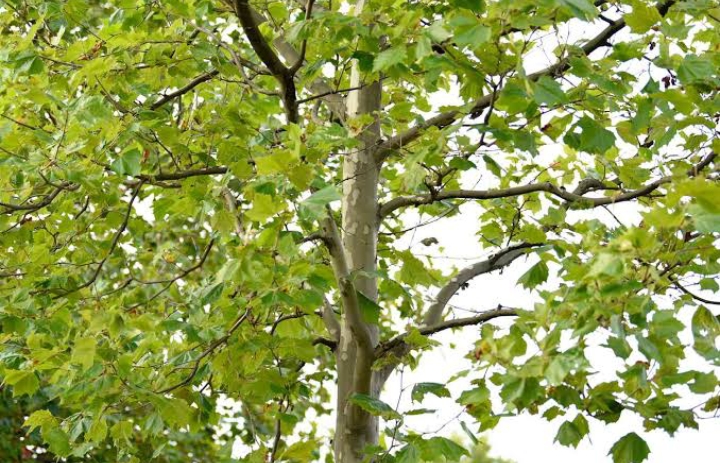
Facts About Sycamore Trees
- Sycamore trees have a long lifespan and can live for several hundred years. Some sycamore trees in the United States are estimated to be over 500 years old.
- The sycamore tree is also known as the buttonwood tree because the wood was once used to make buttons.
- The sycamore tree has a unique way of shedding its bark. As the outer bark dries and cracks, it peels away in large, irregular patches, revealing the smooth, light-colored inner bark underneath.
- Younger sycamores have gray or white bark, while older bark is red or dark gray.
- Sycamore trees begin to bear seeds six or seven years after they are planted, and optimum seed production occurs between 50 and 200 years.
- Sycamore trees have a significant place in folklore and cultural history. In Greek mythology, the god Zeus is said to have been born under a sycamore tree, while in the Bible, Zacchaeus is said to have climbed a sycamore tree to see Jesus.
- Sycamore tree timber is a hardwood with a coarse grain. It has been used to make furniture, flooring, and even the sounding boards of musical instruments such as guitars and violins.
- The largest sycamore tree in the world, located in California, has a trunk circumference of over 100 feet and is estimated to be over 2,000 years old.
- The sycamore tree has a shallow root system and can sometimes cause damage to sidewalks and other structures.
- The sycamore tree is featured in several famous works of art, including Vincent Van Gogh’s painting “The Pink Peach Tree” and Claude Monet’s “Poplars on the Epte.”
- The sycamore tree has a high tolerance for pollution and is often used as a street tree in urban areas.
- The tree produces small, inconspicuous flowers in the spring that develop into round, woody balls that resemble buttons.
- These trees are fast-growing; if they have sufficient moisture when they’re young, they have the potential to grow 2 feet or more annually.
- In the spring, the sycamore tree produces both male and female flowers that bloom in small clusters.
- Fall and spring are the best times to plant Sycamore trees.
- The sycamore tree has a long history of use in traditional medicine especially among the Native American communities. Its bark and leaves were used to treat a variety of ailments, including fever, diarrhea, and respiratory infections.
- Sycamore trees are prone to fungal diseases as they grow. In time, the mature trees tend to become hollow.
- Sycamore tree leaves catch and hold rainwater droplets, which can create a distinctive sound as the water drips off the leaves, providing a soothing and calming effect.
How To Identify a Sycamore Tree – Identification Guide
When you’re beginning to identify tree types, sycamore is one of the first you might commit to memory because it has so many distinctive features. All sycamores are large trees with thick trunks, and range in height from 60 to 100 feet, depending on the species.
All have golf-ball-sized seed clusters covered completely with small, fuzzy spikes. And once established, sycamores have distinctive patchy bark in cream, light green and brown. The bark is easily identified, even from a distance, whether smooth or bumpy.
Size And Form
The sycamore tree is indeed towering in size with a generally imposing appearance. It can grow up to 100 feet tall and can have a trunk diameter of up to 10 feet. However, its size can vary depending on the growing conditions, with some trees growing to be smaller or larger than average.
The tree has a strong central leader that gives it a distinctive pyramidal shape when young. As it matures, the sycamore tree’s growth becomes more horizontal, and its branches spread out to form a broad, spreading canopy. The spreading canopy that can reach up to 70 feet wide.
The sycamore tree’s growth rate is relatively fast, with young trees capable of growing up to 6 feet per year in ideal conditions. This rapid growth rate can make it an attractive choice for landscaping or reforestation projects, as it can quickly establish itself and provide shade and habitat for wildlife.
Leaves
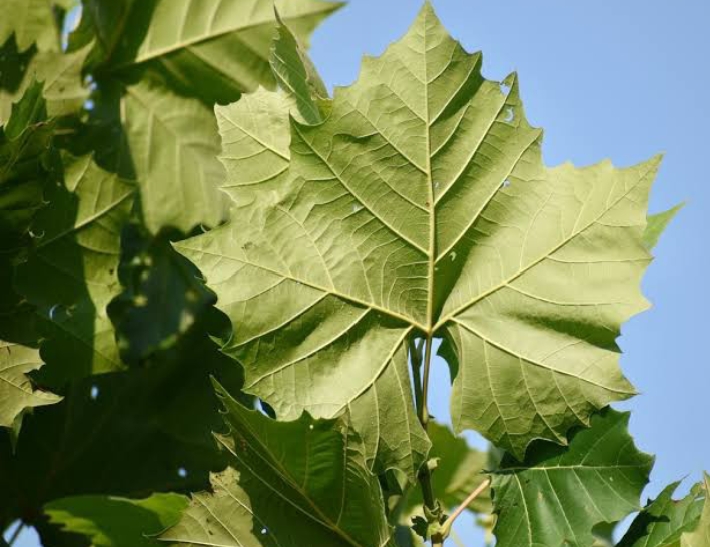
Sycamore tree leaves are large, with a length of about 5 inches and a width of about 6 inches. Actually, the are among the largest leaves of any tree in North America. Structurally, the leaves are palmately lobed, which means that they are divided into several lobes that radiate from a central point, much like the fingers of a hand.
Each lobe is further divided into smaller lobes, giving the leaf a deeply serrated appearance. The edges of the leaf are toothed and irregularly scalloped. The leaf base is usually heart-shaped, and the tips of the lobes are pointed.
The upper surface of the Sycamore tree leaf is dark green, while the lower surface is pale green. The leaves have a soft, velvety texture and their surface is covered with small hairs.
One of the interesting things about the Sycamore tree leaves is their ability to catch and hold rainwater. The water droplets that collect on the leaves can make a unique sound as they fall from the leaves.
In the fall season, the leaves of the Sycamore tree turn a beautiful golden-yellow color. The leaves are known to fall off the tree quite early in the fall season compared to other deciduous trees. The falling leaves create a beautiful carpet of yellow and orange on the ground, providing a striking contrast against the green grass.
The Sycamore tree leaves have several practical uses. They are used as a natural mulch, which helps to retain soil moisture and suppress weed growth. The leaves can be added to compost to enhance the soil quality. In traditional medicine, the leaves are used to treat a range of ailments, including fever, cough, and inflammation.
Flowers
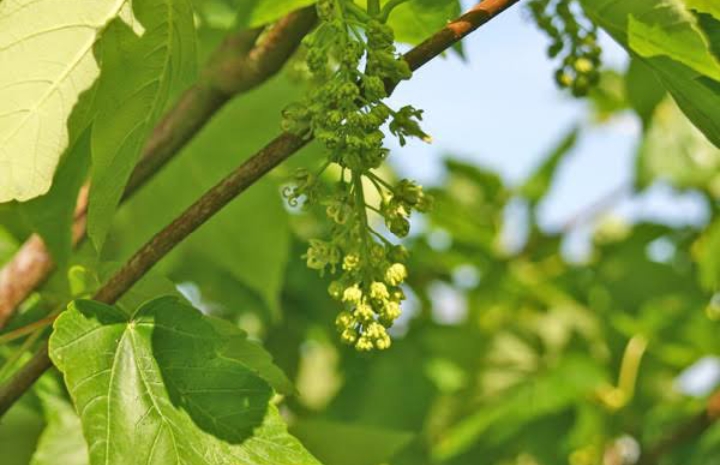
Sycamore tree flowers are small and inconspicuous, with both male and female flowers growing on the same tree. The flowers appear in the early spring, usually before the tree’s leaves have fully developed. The male flowers grow in dense clusters on long, drooping stalks, while the female flowers grow in smaller clusters close to the branch tips.
The male flowers of the sycamore tree are yellow-green in color and have a slightly curved shape. Each male flower consists of several stamens, which are the male reproductive structures that produce pollen.
The female flowers of the sycamore tree are also yellow-green and have a round, ball-like shape. Each female flower consists of a single ovary, which is the female reproductive structure that contains the developing seeds.
While the flowers of the sycamore tree may not be as showy as those of some other tree species, they are an important part of the tree’s reproductive process and contribute to the overall beauty and ecology of the tree.
Bark
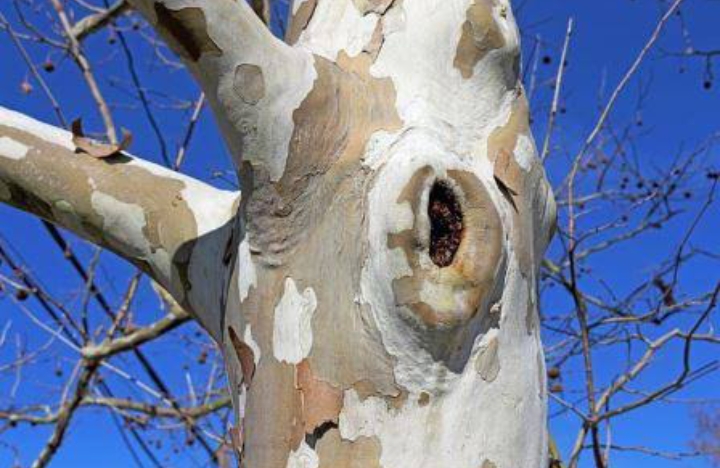
There is no way you can talk about the sycamore without talking about its bark. The bark of this tree both on the trunk and branches generally features a mottled, patchwork appearance, something that sets the tree apart from other tree species. This is usually due to exfoliation or peeling away of large, thin sheets of bark.
When the sycamore tree is young, its bark is thin, smooth, and light gray in color. As the tree matures, the bark becomes thicker and develops deep fissures and ridges. The older bark is a mottled combination of white, green, tan, and brown, with patches of smooth and rough texture.
The patchwork pattern of the sycamore tree bark is caused by the shedding of the outer layers of bark as the tree grows. The outermost layer of bark, called the periderm, is constantly being shed and replaced by new layers of bark underneath. This shedding process creates the distinctive patchwork appearance of the bark.
The sycamore tree bark also serves an important ecological function. The rough, textured bark provides a habitat for a variety of insects, such as beetles and moths, as well as small animals, such as bats and birds. The bark also protects the tree from damage caused by insects, diseases, and extreme temperatures.
Branches
The sycamore tree has several distinct branches that grow from its trunk, each with its own characteristics and functions. The branches are usually in two forms: main and secondary.
- The main branches of the sycamore tree are the primary extensions of the trunk that grow outward and upward. These branches are thick and sturdy, and they can reach up to several feet in diameter. The main branches provide support for the entire tree and help it to maintain its upright position. As the tree grows, the main branches will continue to extend and produce smaller secondary branches.
- The Secondary branches grow off of the main branches and are smaller in diameter. They are responsible for producing leaves, flowers, and fruit, and they are also important for providing shade and shelter for animals. The secondary branches are more flexible than the main branches, which allows them to sway in the wind without breaking.
Fruit or Seed Balls

Sycamore fruit, also known as seed balls or samaras, are an important part of the reproductive system of the sycamore tree. These unique structures are formed when the female flowers of the sycamore tree are pollinated by wind-borne pollen. Once pollination has occurred, the female flowers develop into clusters of small greenish-yellow fruits, each about the size of a golf ball.
As the fruit matures, it becomes brown and woody, and develops a series of characteristic spikes or knobs. These spikes are actually the remains of the flower’s sepals, which protect the developing fruit during its growth. Inside the fruit are several small, flattened seeds that are attached to a central stalk.
The mature sycamore fruit eventually falls from the tree and is dispersed by wind, which can carry it for several miles from the parent tree. Once the fruit lands on the ground, it will eventually decompose, releasing the seeds to germinate and grow into new sycamore trees.
Root System
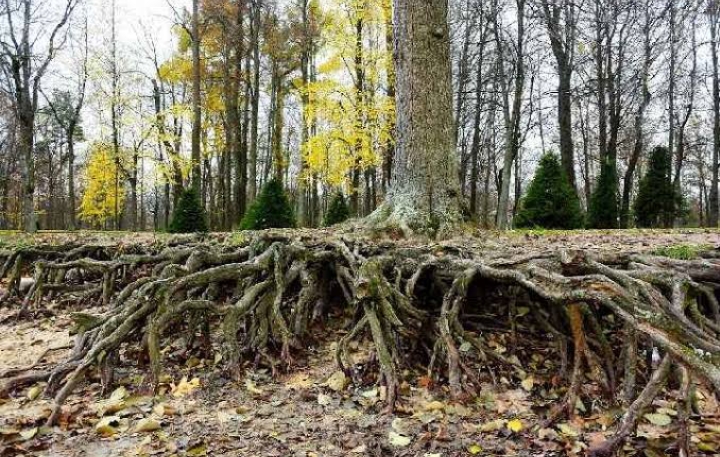
The sycamore tree has a shallow root system that is often broader than the tree’s canopy, extending outward to a distance of two to three times the tree’s height. The roots typically grow in the top 2 to 3 feet of soil and can spread laterally up to 100 feet, depending on the availability of water and nutrients.
Despite its shallow root system, the sycamore tree is highly adaptable and can tolerate a wide range of soil conditions. It can grow in soils that are poorly drained, compacted or polluted. Thus, why in many places in North America, you’ll find the sycamore growing along streetscapes in both urban and suburban settings.
One good thing about sycamore tree’s shallow root system is its ability to stabilize soil and prevent erosion. The tree’s roots help to hold the soil in place, reducing the risk of landslides or other forms of erosion.
The shallow root system of the sycamore tree can also pose some challenges. The tree’s roots have a tendency to grow above ground, which can create a tripping hazard for people walking or running in the vicinity. It can also cause damage to nearby structures such as sidewalks, driveways, and even buildings. The roots may invade sewer lines, drainage pipes, and irrigation systems.
Winter Twigs
The buds on sycamore twigs are one of the key ways to identify the tree during the winter months, when the leaves have fallen off.
The twigs are generally quite stocky, brown with quite prominent, pointed buds, that occur in opposite pairs. The buds are enclosed by green scales that have brown tips. Sycamore buds are around 1/8 inch in size. When the bud opens, the scale leaves fall away leaving a girdle scar that surrounds the stem.
Types/Varieties of Sycamore Trees
There are about eight species of sycamore, six of them native to North America. Most are large, majestic trees with spreading canopies, large lobed deciduous leaves, and white bark peeling to reveal darker patches.
In other parts of the world, sycamore refers to trees not related to Platanus, the sycamore fig (Ficus sycomorus) of Africa and Mediterranean areas and the Eurasian sycamore maple (Acer pseudoplatanus).
Here is a list of Sycamore tree varieties:
- American Sycamore (Platanus occidentalis)
- California Sycamore (Platanus racemosa)
- Mexican Sycamore (Platanus mexicana)
- Arizona sycamore (Plantanus wrightii)
- English sycamore or London Plane (Platanus x acerifolia)
- Oriental sycamore (Platanus orientalis)
American Sycamore
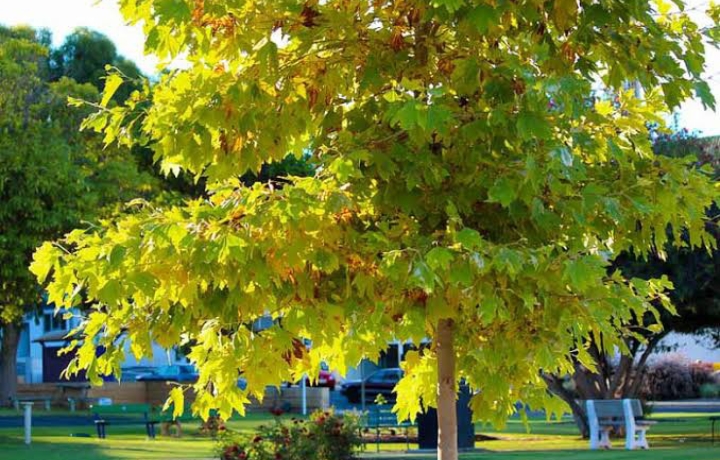
The American sycamore also called American plane tree or Eastern Sycamore is native to North America. American sycamores are among the largest trees in the U.S. eastern, mixed-hardwood forests. Mature specimens are often 80 to 100 feet tall with trunks 6 feet across; exceptional trees may be roughly twice that size.
Its distinctive mottled bark, flakes off in large irregular patches to reveal the smooth white bark underneath. The bark can also appear as a light greenish-gray or brownish-gray color.
American sycamores are used for streets, parks, reclamation projects and home landscaping. Some specimens are more than 400 years old.
California Sycamore
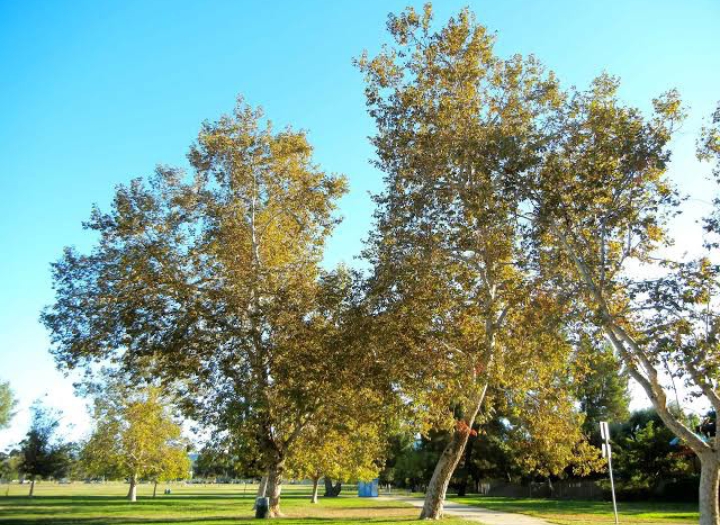
The California sycamore, also known as the western sycamore or California plane tree is a medium to large-sized tree native to Baja California and Mexico. This tree is easy to identify as it features a striking white bark, which peels off in thin flakes or sheets to reveal patches of green or gray-brown underneath.
The California sycamore is a fast-growing tree, it can grow up to 100 feet tall with a trunk diameter of up to 10 feet in under 30 years. This tree is well adapted to the hot, dry summers and mild, wet winters of California’s Mediterranean climate. It is widely planted parks, gardens and many other public spaces in California.
Mexican Sycamore
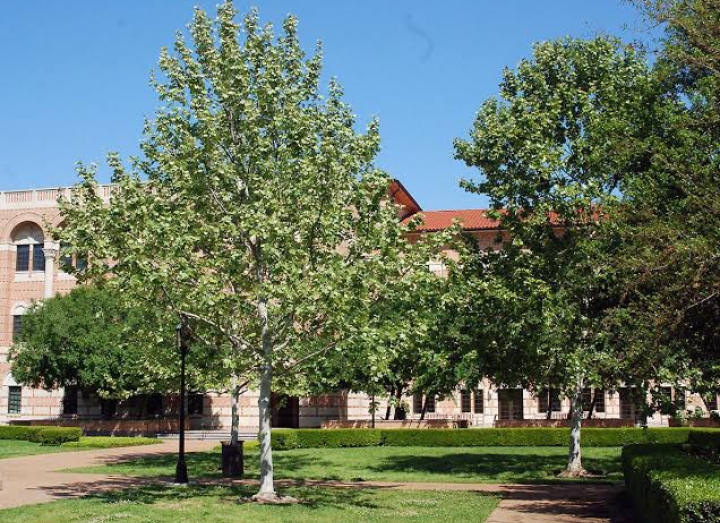
The Mexican sycamore tree, also known as the Ahuehuete tree is native to Mexico and Central America. The Mexican sycamore is well adapted to hot, dry environments and can tolerate drought and poor soil conditions. It also grows well as far north as USDA Cold Hardiness Zone 8b in Texas and Florida.
Mexican sycamore is slightly smaller than the American sycamore. While known to grow up to 80 feet or more in the wild, Mexican sycamore gets to a mature height of 50 feet in the landscape with a width of about 30 feet. It is often used in urban forestry projects and to restore degraded ecosystems.
Arizona Sycamore
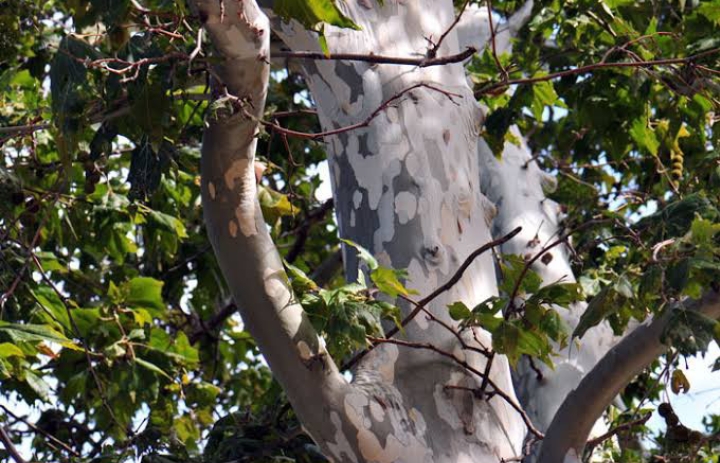
The Arizona sycamore, also known as the Canyon sycamore greatly resembles California sycamore, and some botanists regard it as a subspecies of California sycamore. It is native to canyons, streams and rivers in south and central Arizona, extending to adjacent western New Mexico and northern Mexico.
The Arizona sycamore can grow up to 80 feet tall and has a trunk diameter of up to 4 feet. It is well adapted to the hot, dry conditions of the desert Southwest and can tolerate drought and poor soil conditions.
Like other North American sycamores, Arizona sycamore can easily be identified by its sculptural trunk and branches and its beautiful white bark that peels to show areas of mottled tan, brown and gray.
English sycamore
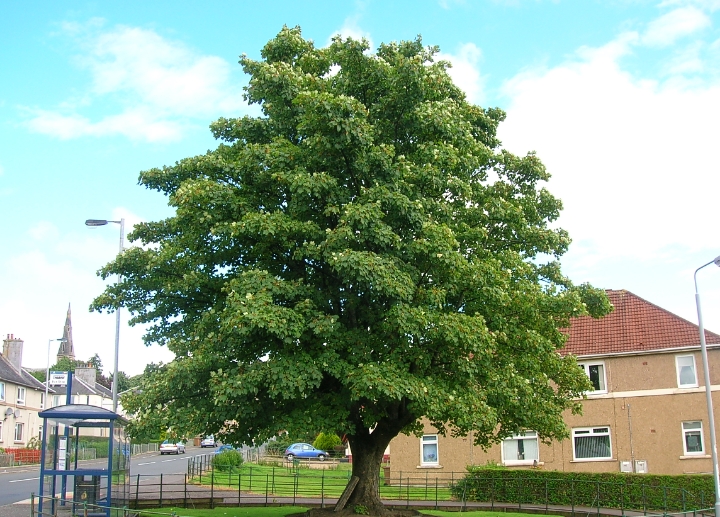
English sycamore is hybrid between American sycamore and Oriental sycamore (Platanus orientalis). It is native to Europe and Western Asia, but has been widely planted in many parts of the world, including North America. The tree is also known by other common names such as false plane and London plane tree.
One of the identifying features of the English sycamore is its bark, which is smooth and grayish-brown in young trees, but becomes rough and scaly as the tree ages. The bark can also have a mottled appearance with patches of light and dark areas.
English sycamore is smaller and straighter than other sycamores. It generally grows between 30 and 60 feet tall. When planted as a street tree in some U.S. cities, London plane tree is pollarded, a pruning practice where main branches are cut back to stubs each year.
The Oriental Sycamore

The oriental sycamore also referred to as the Old-World sycamore or Oriental plane is native to Eurasia from the Balkans to at least as far east as Iran. Some accounts extend its native range to Iberia in the west, and to the Himalayas in the east.
The Oriental sycamore is a medium-sized tree that can reach up to 50 feet tall. Its leaves are palmate, like those of the English sycamore, but are smaller in size. In autumn the deep green leaves may change to blood red, amber, and yellow.
Just like other North American Sycamore, bark of this tree is smooth and gray when young, but becomes gray-brown and furrowed as the tree matures. The bark has a distinctive diamond-shaped pattern that becomes more pronounced as the tree ages.
The oriental plane is found naturally in riverine settings, together with such trees as alder, willow and poplar. However, it is quite capable of survival and success in dry soils once it is established.
How to Grow Sycamores From Seeds
- Sycamore seeds are called samaras and can be found on the tree during late summer or early fall. They are winged seeds that are about 1 inch long and can be found hanging in clusters from the branches.
- Select and gather a seed ball with a golden-brown or grayish coloration. Avoid those with signs of mildew or an excessively wet, squishy feel when squeezed.
- Place the sycamore seed ball inside a paper bag. Fold the top closed. Gently tap the seed ball with a rubber mallet to break apart the seeds.
- Soak the seeds in a bowl of water for a few hours. This will help to remove any debris or dirt from the seeds.
- If you choose to plant the seeds in a pot, fill the pot with a mixture of potting soil and sand. Sow the seeds about 1 inch deep in the soil, then water the soil until it is moist.
- If you choose to plant the seeds directly into the ground, find a sunny location with well-drained soil. Clear any debris or weeds from the area and dig a hole that is twice the size of the seed. Sow the seed about 1 inch deep in the hole, then cover with soil.
- Sycamore seedlings need to be watered regularly to keep the soil moist. They also need to be protected from direct sunlight, so it’s best to plant them in a location that receives partial shade.
- Watch for signs of germination in four to six weeks. Once the seedlings are about 6 inches tall, you can transplant them into larger pots or into the ground.
- When transplanting the seedlings, make sure to dig a hole that is twice the size of the root ball. Fill the hole with soil, then water the plant thoroughly. It’s also a good idea to add a layer of mulch around the base of the tree to help retain moisture.